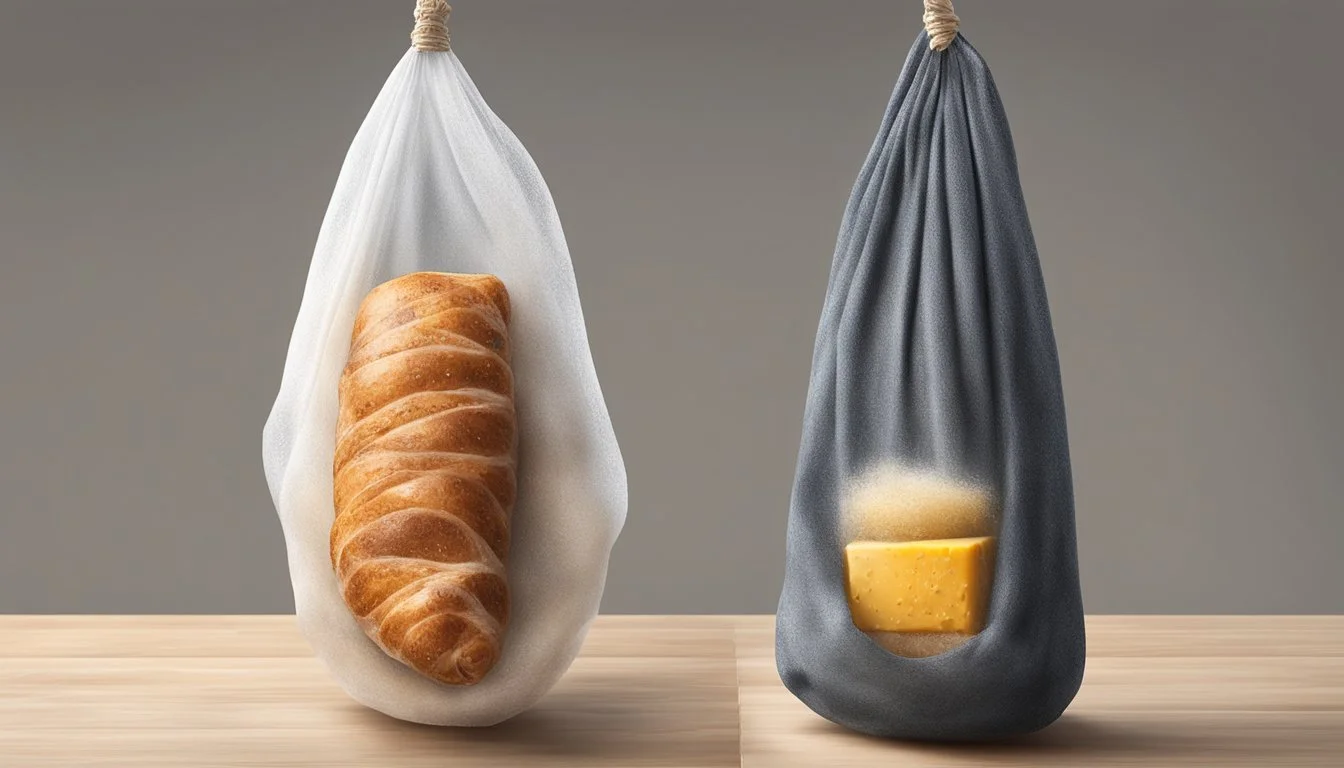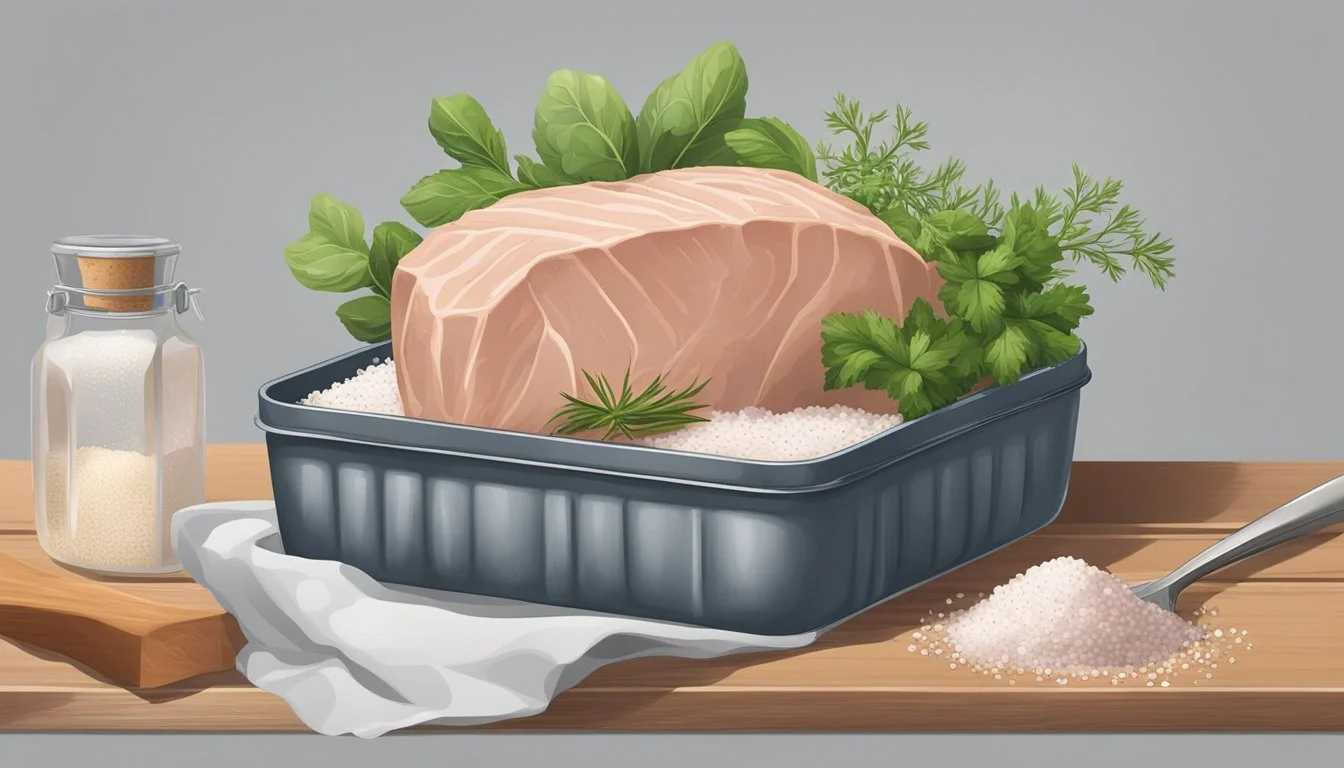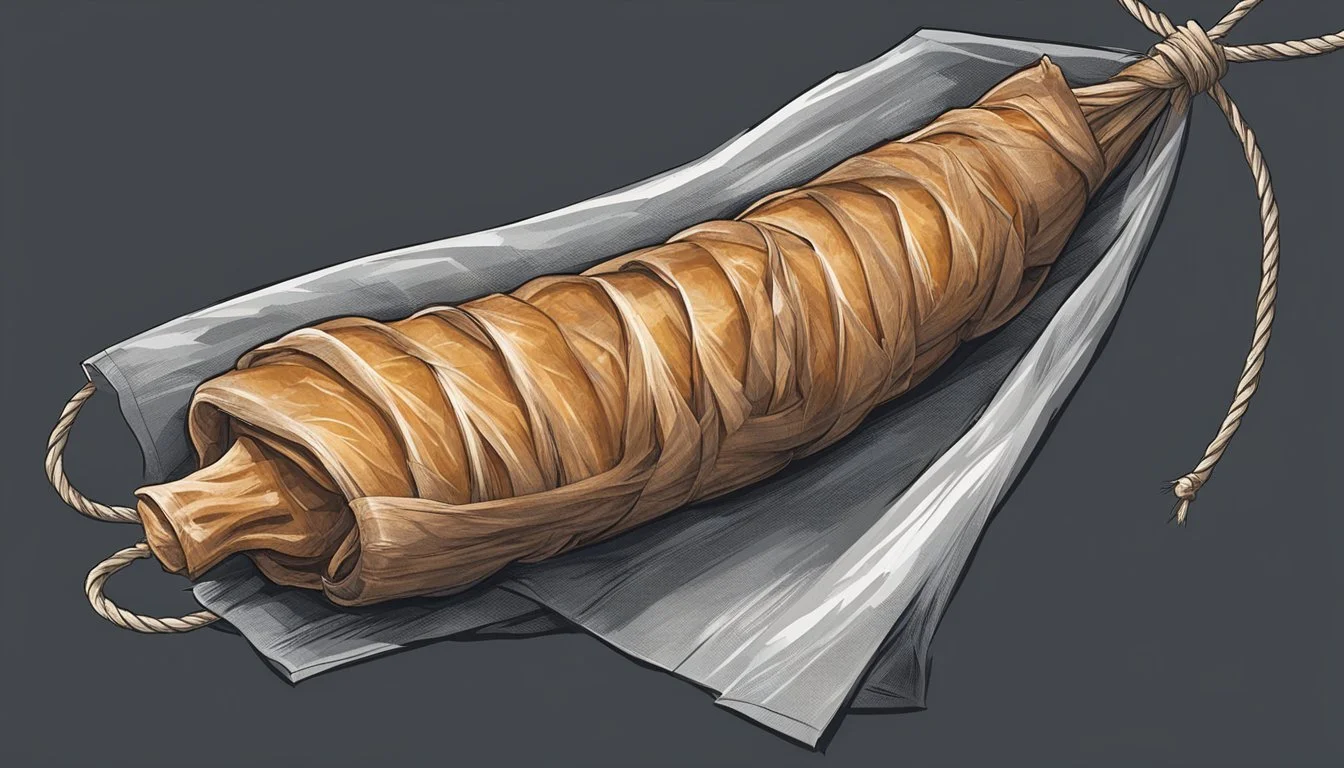How to Ferment Lonzino
Mastering Italian Cured Pork Loin at Home
Lonzino is a treasured part of Italian charcuterie (What wine goes well with charcuterie?), a craft dedicated to the preservation and flavoring of meat. It involves curing and drying a pork loin, a process that transforms the fresh meat into a rich, concentrated delicacy. This process of fermenting lonzino not only enhances its taste through natural enzymatic and bacterial activity, but also extends its shelf life, enabling it to be savored over extended periods.
Cured meats like lonzino boast complex flavors and textures that are developed through careful preparation and patience. The curing mixture, typically consisting of salt and a blend of spices, is meticulously rubbed onto the pork loin before it undergoes a controlled drying period. Fermentation occurs during this phase, where beneficial bacteria contribute to the meat's distinct flavor profile and safety.
In the artisanal tradition of Italian lonzino, the meat is often prepared without commercial curing mixes, relying instead on time-honored methods of seasoning and fermenting. The techniques, passed down through generations, emphasize the quality of the pork loin and the precise balance of salt and spices, resulting in a product that is not only a tribute to culinary heritage but also a sublime eating experience.
Selecting the Pork Loin
When fermenting Lonzino, the journey begins with the most crucial step: selecting the right pork loin. A high-quality starting point ensures a flavorful, authentic final product. The choice of meat, its heritage, and initial preparation set the stage for an excellent Lonzino.
Choosing High-Quality Meat
One must seek out pork loin that exhibits a deep pink color, indicating freshness and proper processing. The meat should have a fine grain with a moderate amount of marbling; this ensures a perfect balance of lean muscle and fat, which is essential for the curing process. It is also imperative to consider the initial weight of the pork loin, as it influences the curing time and the spice ratios.
Heritage Breed Considerations
Considering heritage breeds can be beneficial as they often offer superior taste and texture, characteristic of traditional Lonzino. Breeds such as Berkshire or Tamworth, known for their well-marbled meat and distinctive flavor profiles, are excellent choices. Their slower growth rate and genetically diverse background can contribute to a more savory and nuanced end product.
Preparing the Meat
Before the fermentation process begins, the pork loin should be prepared with care. Trim any excess fat, leaving just enough to enhance flavor. Ensuring that the meat is at a uniform size helps in even curing. Moreover, the preparation stage is an opportune time to calculate the necessary amounts of curing salts and spices based on the pork loin's initial weight.
Curing Process
The curing process of Lonzino involves mixing a specific cure, applying it thoroughly to the pork loin, and then allowing the meat to cure under controlled conditions for an optimal period.
Mixing the Cure
To begin, one must mix the curing agents. Typically, 35 grams of salt per kilogram of pork loin is a good starting point. For food safety, 2.5 grams of curing salt (Cure #2) for each kilogram is also essential. A balance of both kosher or sea salt and sugar is mixed with the curing salt to draw moisture from the meat and aid in preservation. It's crucial to mix these dry ingredients uniformly.
Ingredients:
Salt: 3.5% of meat's weight
Sugar: 1-2% of meat's weight
Curing salt #2: 0.25% of meat's weight
Applying the Cure
Even distribution of the cure over the pork loin is critical for an even cure. Every surface of the meat should be covered, rubbing the mixture in thoroughly. Extra cure mixture can be put into the bag with the meat. Subsequently, the pork loin is placed in a vacuum sealer bag or Ziploc bag, which is crucial to prevent contamination and ensure an even cure.
Steps for application:
Cover all sides of the pork loin with the cure mix.
Place the meat in a vacuum sealer bag or Ziploc bag.
Add any remaining cure mix into the bag with the meat.
Curing Time and Conditions
The pork loin should be stored in the refrigerator for a period ranging from one week to 12 days. Temperature should be consistently kept around 2-4°C (35-39°F). This period allows the cure to penetrate the meat evenly, facilitating a controlled reduction in moisture and ensuring a safe curing process. After the refrigeration phase, the pork loin should be thoroughly rinsed to remove excess salt.
Curing conditions:
Temperature: 2-4°C (35-39°F)
Duration: 7-12 days (or until the meat has firmed up)
Seasoning and Flavoring
The careful selection and application of seasonings are crucial for crafting a Lonzino with a rich and authentic flavor profile. One's choice of spices and herbs, as well as the technique for applying them, can significantly influence the taste and aroma of the finished product.
Selecting Spices and Herbs
The spices and herbs chosen for Lonzino can vary depending on personal preference, but there are some traditional ingredients that are typically used to achieve the characteristic Italian flavor. Black pepper and garlic powder are staples for their robust flavors. Subtle heat can be introduced through cayenne pepper, while fennel seeds add a hint of sweetness and anise-like taste. Paprika, both sweet and smoked varieties, imparts a warm, smoky essence to the meat, and onion powder complements this with its savory notes. For a more complex palate, white pepper may be used as a subtler alternative to black pepper.
Here is a basic spice blend one might consider:
Black pepper: 1 tablespoon
Garlic powder: 2 teaspoons
Sweet paprika: 1 tablespoon
Fennel seeds: 1 teaspoon
Cayenne pepper: ½ teaspoon (optional for heat)
Onion powder: 1 teaspoon
White pepper: ½ teaspoon (optional for a more complex flavor)
Applying the Seasoning
After selecting the spices and herbs, it is essential to apply them uniformly to ensure even flavoring. Begin by mixing the spices in a bowl, maintaining proportions to balance the taste. The loin should then be thoroughly coated with the blend, allowing the seasonings to penetrate the meat surface.
For the best results, follow these steps:
Prepare the spice blend: Combine all selected spices and herbs in a bowl.
Coat the loin: Rub the mix onto all sides of the pork loin evenly.
Rest the meat: Once coated, allow the meat to sit with the seasoning blend, further absorbing the flavors before the cure.
When applying wine, which is sometimes used to enhance the flavor, it should be lightly brushed onto the pork loin before the dry seasonings are added. This helps the spices adhere better and infuses the meat with the wine's subtle fruity notes.
Remember to avoid over-seasoning, as the goal is to complement, not overpower, the natural taste of the pork. The seasoning acts as a precursor to the curing process and sets the stage for a well-balanced Lonzino.
Wrapping and Trussing
Wrapping and trussing Lonzino ensures even drying and preserves the shape of the pork loin during the curing process. This section details the methods for securing the meat, protecting it during fermentation, and preventing mold growth.
Using Butcher's Twine
To properly truss the Lonzino, one should utilize butcher's twine, which offers the strength and durability needed for hanging the meat. Trussing involves tightly wrapping the twine around the pork loin in a uniform manner to maintain its shape and ensure even exposure to curing conditions. Here are steps to follow:
Lay the pork loin flat on a clean surface.
Cut a length of butcher's twine long enough to wrap around the loin multiple times.
Begin at one end of the loin and tie a secure knot.
Wrap the twine in evenly spaced loops around the length of the loin.
Finish with a knot at the opposite end, ensuring the twine is snug but not cutting into the meat.
Applying Sausage Netting
For additional support, especially for larger cuts, sausage netting can be applied over the butcher's twine. The netting helps in maintaining a compact shape and provides an even surface for the curing process. To apply sausage netting:
Slide the netting over the trussed pork loin.
Adjust to cover the loin uniformly, making sure the netting is not twisted or bunched up.
Preventing Mold Growth
During fermentation, controlling mold growth is crucial for safety and quality. White mold is typically harmless and can even contribute to the flavor, while black and green molds are undesirable and potentially harmful. To prevent harmful mold growth:
Ensure the meat is well-covered using butcher paper or in a vacuum-sealed environment if the fermentation process allows for this method.
Monitor the Lonzino regularly for signs of unwanted mold.
Maintain proper humidity and temperature during curing to discourage mold growth.
Drying and Aging
Successful drying and aging are crucial to the creation of Lonzino, a delectable Italian cured and dried pork loin. This process matures the meat, concentrating its flavor and establishing its distinctive texture. Proper environmental controls for humidity and temperature are essential for food safety and quality.
Setting Up a Curing Chamber
The curing chamber is where Lonzino will spend several weeks transforming into a dry-cured meat. An ideal chamber can be a modified refrigerator or a commercial curing chamber. To set up a curing chamber:
Temperature Control: Maintain a steady temperature between 53-59°F (12-15°C).
Humidity Control: Aim for 70-80% relative humidity.
These conditions mimic a traditional cellar environment, which is critical for the meat's gradual dehydration without spoilage.
Controlling Humidity and Temperature
Precise environmental control is paramount in producing quality Lonzino. To manage these conditions:
Use a hygrometer-thermometer to continually monitor the chamber's climate.
Set up a humidifier and dehumidifier to regulate humidity levels effectively.
It's important to achieve a balance that avoids excessive drying or moisture, which can spoil the meat or encourage bad mold growth.
Monitoring Weight Loss
Monitoring the weight of the Lonzino provides an objective measurement of the drying process. To ensure the correct level of dehydration:
Weigh the meat before it enters the chamber to have an initial reference point.
Record the weight weekly, aiming for a 30-40% weight loss from the original weight.
Once the desired weight loss is achieved, the texture of the Lonzino should be firm but not hard, signaling that it is ready for consumption.
Careful attention to these parameters ensures the Lonzino will dry age correctly, developing its rich flavor and proper texture.
Post-Curing Treatment
After the initial curing phase, Lonzino requires careful handling to ensure safety and optimal maturation. The post-curing treatment involves several important steps, each critical to the quality of the finished product.
Vacuum Sealing for Equilibrium
Once the pork loin has absorbed the cure, it should be vacuum sealed. This technique assists in creating an equilibrium whereby the salt and seasoning are uniformly distributed throughout the meat, a key aspect of flavor development.
Process:
Place the cured loin in a vacuum-sealable bag.
Ensure all air is expelled to prevent bacterial growth.
Seal the bag completely using a vacuum sealing machine.
Identifying Off-Flavors
During curing, off-flavors can develop, which indicate spoilage or incorrect fermentation. Regularly check for unusual or pungent odors, sourness, or any signs of visual spoilage.
Inspection:
Sight: Look for discolorations or mold not typical to the curing process.
Smell: Detect any off or rancid odors that are not characteristic of Lonzino.
Refrigeration Storage
After sealing, the Lonzino should be kept in refrigeration at a consistent temperature to slow down the bacterial activity and continue the curing process safely.
Temperature: Keep below 40°F (4.4°C) to ensure food safety without freezing the meat.
Duration: Store in a cool place for a week to several weeks depending on the recipe specifics and desired firmness.
Monitoring: Check the temperature regularly and adjust the refrigerator settings if necessary.
Serving and Enjoying
Once the lonzino has been properly cured and dried, it becomes a delightful addition to any charcuterie spread. Mastery in serving lies in how it's sliced and what it's paired with to enhance its rich flavors.
Slicing the Lonzino
The lonzino should be sliced very thinly, similar to prosciutto or pancetta. Thin slices ensure that one can appreciate the delicacy of the meat's flavor and texture. The use of a sharp knife or a meat slicer is recommended for achieving consistently thin slices. Each slice should ideally be translucent and nearly melt in the mouth when tasted.
Use a Sharp Knife: A razor-sharp knife allows for precision and thin slicing.
Consistency: Aim for consistently thin, translucent slices.
Room Temperature: Serve the lonzino at room temperature to maximize flavor.
Pairing Suggestions
When serving lonzino, the accompaniments should complement the savory and slightly nutty flavor profile of this air-cured pork loin. Here are some pairing suggestions:
Cheese: Aged hard cheeses such as Parmigiano-Reggiano or Pecorino.
Bread: Fresh, crusty bread like a baguette or ciabatta.
Wine: Medium-bodied red wines or crisp white wines.
Fruit: Figs or melon can provide a sweet contrast to the lonzino's savoriness.
Ideal Pairings for Lonzino:
Cheese: Examples - Parmigiano-Reggiano, Pecorino
Bread: Examples - Baguette, Ciabatta
Wine: Examples - Chianti, Pinot Grigio
Fruit: Examples - Figs, Melon
By mindfully slicing and thoughtfully pairing the lonzino, one can truly savor the excellence of this traditional Italian cured meat. Its versatility makes it an exemplary choice for a range of culinary experiences, from simple plates to sophisticated gastronomic creations.
Understanding Food Safety
When fermenting lonzino, food safety is paramount. One must ensure that Cure #2, a curing salt containing sodium nitrite and sodium nitrate, is used correctly to prevent the growth of harmful bacteria, including Clostridium botulinum. It's essential to measure the appropriate amount of Cure #2 based on the weight of the pork loin to ensure safety.
Brining is a step often included in meat curing, which not only flavors the meat but also acts as an additional hurdle against microbial growth. Salt concentration in the brine is critical and should be precisely followed according to the recipe.
Here is a basic structure one might follow to maintain food safety standards:
Initial Meat Preparation:
Ensure pork loin is fresh and handled with clean equipment.
Application of Cure #2:
Adhere to recommended ratios of Cure #2 proportionate to meat weight.
Apply cure mixture thoroughly and evenly.
Molding Concerns:
Inspect for unwanted mold growth throughout the curing process.
Beneficial white mold is often indicative of a controlled fermentation environment and may be encouraged, but any signs of green, black, or fuzzy mold require attention.
Vinegar can be used to wipe down the meat before and after the curing process to minimize surface bacteria, which can help inhibit the growth of undesirable mold.
Throughout the fermentation and drying process of lonzino, maintaining a consistent, cool temperature and proper humidity levels significantly contributes to food safety. The environment should be closely monitored since it directly impacts both flavor development and safety.
Lastly, one should always follow the latest food safety guidelines, such as those issued by food safety authorities like FSIS. They offer comprehensive information on the safe handling, fermentation, and drying of cured meats, like lonzino, to ensure they are ready-to-eat and free from health risks.






